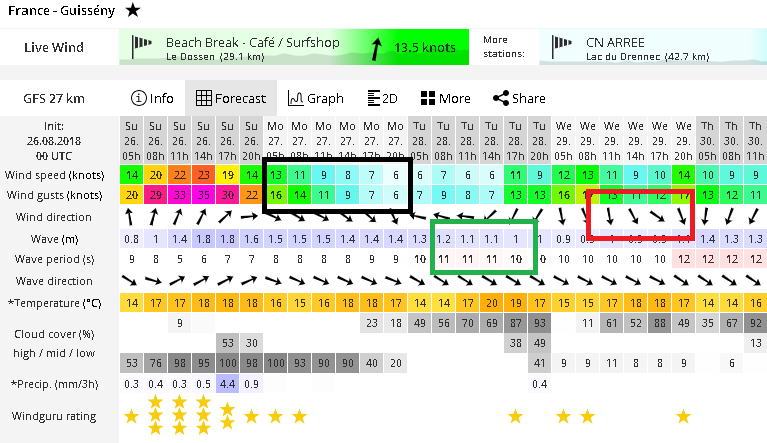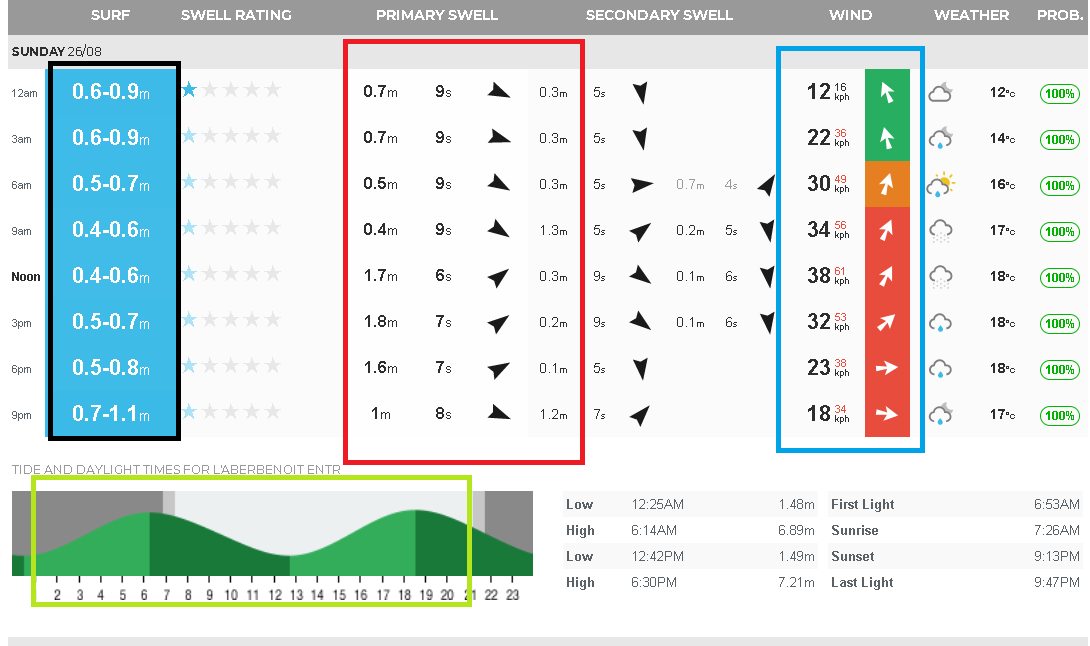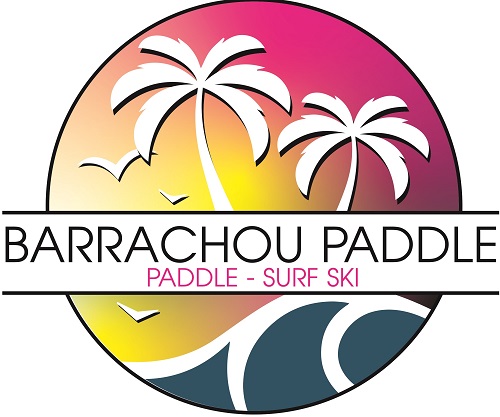Are you new to SUP paddling? And are you unsure how to plan your session to avoid being blown out to sea? It is not easy to plan and the last thing you want is to be that person who is rescued by the RNLI.
So here is my guide to knowing when is a good time to paddle or not!
For most of my sessions I use windguru, this is the best fit for where I live. I can see the wind, the wind direction, the wave height and the wave periods.
I can also see the pattern of weather that will come, so I can plan ahead.

Waves
Waves: The green box signifies the wave data. Look out for the height, Personally something over 1.2m is fun for SUP surfing all the way to 2m. But for touring on your iSUP this is not easy paddle conditions. You should be looking for 0.5m max.
But this is dependent on the spot. For example when La Torche and La Palue (2 spots in Bretagne/ Brittany,France) states it its 2m it really is 2m and possibly 2.5m in a set, and heavy. Then my normal spot Goulien in Crozon when it says it is 1.5m, it will be 1.2m, highest wave in the set is 1.5m. This is a function of the beach profile, and orientation of the beach to the swell.
The Wave period is important. You want to look for something along the lines of 10 / 11 seconds between each wave if you want to SUP surf or downwind. Those of us on the Atlantic coast, in the UK, or in France, we get our swell from the Atlantic, so it has a long way to travel to get to us (called fetch), so we are used to numbers around 10 or 11.
Those who surf on the East coast of the UK, or on the other side of the North sea, Denmark, the swell is generally from wind so the numbers are 8 or 9, still good. So it is all dependent on where you are for the numbers.
2 or 3 up to 7 seconds between each wave is wind swell this indicates you will be having a wobbling time on choppy water.
Wind Speed
Wind Speed: The black box signifies the wind speed and gusts in knots, I use knots (knots= Kph x 1.85 or 2 if you want to keep it simple). But in windguru they help us by colour mapping what is good and bad for your sport. Green and light blue for surfing and SUP surfing is great. Purple for windsurfing. Downwind SUP yellow / orange and even purple.
Wind is the SUPrs friend or foe. Generally up to 13 KM/h is manageable . After this you need to think about what direction it is blowing. And if you have the correct level to go out paddling.
Wind Direction
Wind Direction: This is in the red box. This is important to us in the water.
I sup surf so I’m constantly looking at the wind, I can be out in up to 20 KM/h but after that it becomes technically difficult to paddle, and sometimes tiring if I am out on a smaller volume board. SO what do you look for?
On shore wind is ok for SUP surfing at 25KM/h the wind will push the wave down, so it may be difficult to take off on it.
For SUP touring this is the perfect wind because eventually you will get pushed back onshore.
Off shore wind is good, this will jack up the wave and make it steeper, so easy to take off on.
For SUP touring this is to be avoided!
Side shore / cross shore, this lies somewhere in the middle for quality of wave, again it depends on what spot you are in.

Example from my normal spot in Crozon, France.
I normally surf on the red star, this can take onshore and offshore wind. The offshore arrow being the one that starts on the land and finishes at sea, the onshore the opposite.
So if I position myself at the red star I can imagine what would happen to myself if I was to get in at this point and start paddling an iSUP in 60KM/h, in shore or offshore.
When it is blowing side shore I move up to the north part of the beach and then it is more sheltered. Something that you should consider.
We never get southerlies but if we did I would stay in the red spot. So always go where the wind is good.
A good wind predictor is the app windty . You can run the simulation to predict the strength and direction of your choosen site.
Tides
The world’s largest tidal range of 16.3 metres (53.5 feet) occurs in Bay of Fundy, Canada, and the United Kingdom regularly experiences tidal ranges up to 15 metres (49 feet) between England and Walesin the Severn Estuary
Unfortunately for us living here in Finistere and the UK we do have a lot of difference between low and high tide, depending on the coefficient, or the phase of the moon.
My spot Goulien works well going onto high and 1 hour after low. My really local spot, which is 2 km from my house works ONLY 1 hour before and after high tide when the coefficient is more than 70.
Tides can be tricky here is a link to a more in depth article of tide prediction.
Magic Seaweed Explained
I sometimes use magic seaweed (MSW) for spots that I don’t know (basically anything out of finistere in France). And mostly for SUP surfing.

I have put in the my local spot Boutrouilles.
Today it is bad. I only look at the black box to see the height of the surf 0.6 – 0.9m its ok. But then I look at the blue box and I see 38KM/h gusting to 61KM/h, windy and stormy, and possibly blown out. I never really look at the red box for data, but I do sometimes look at what direction the waves are coming in at.
For Boutrouilles spot to work the swell needs northwest to north-north west. The tide chart also tells me when high tide is happening so I can be there for 1 hour before. However, MSW does all the work for me and gives me a colour indicator Red being bad – Green being good I’d say today it’s pretty accurate – not surfing weather but I’ll go for a surfski).
Now compare this too later on in the week. The black shows a good swell height, so fun waves to be had, maybe I ‘ll take my longsup out. The red box tells me the wave direction is good for this spot. The wind is low and good! The sun is out, and the tide is high at night so I can go for a sunset paddle.

Finally, the waves you get are all dependent on the beach profile of your beach, will it be a nice peeling wave or will it be a gutsy heavy wave. The only solution to that is to go out and watch other people. Remember the waves always look smaller than they are!
There are other forecast tools
surf-forecast.com and surfline (surfline I use when I go to Los Angeles to surf). The key is finding what is right for your spot, and for you.
What to learn more about SUP session planning? Then come along to the Wild Women SUP Symposium in September. The perfect place and time to learn more about SUP paddling!

